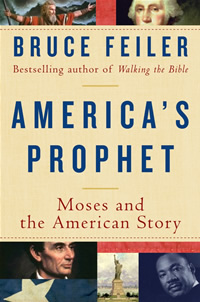When Martin Luther King Jr. stood to speak at the Mason Temple in Memphis on the night of April 3, 1968, storms, both atmospheric and social, were raging in west Tennessee. Inside the hot, humid hall, no one knew what Dr. King would say or had any hint that it would be his last speech. As usual, he didn’t disappoint his audience. He built slowly but steadily to a crescendo accompanied by the thunder, finishing with reference to a story that has inspired and guided Americans since the Pilgrims. King proclaimed that he had been to the mountaintop, that he had seen the promised land, and that his people would reach that land even if he could not be with them when they did. As an American pastor, he knew what he was doing. His dramatic and too-prophetic words echoed the story of one person to whom every American, black or white, could easily relate: Moses.
In a tour-de-force of popular history, America’s Prophet: Moses and the American Story, author Bruce Feiler has placed Dr. King’s last public words in a continuum that begins with Columbus, persists through Ronald Reagan and Barack Obama, and has no end in sight. In a literary world deluged with books in which historians, journalists, and politicians incessantly reexamine and revise histories of every individual war and social movement, Feiler has contributed a genuinely new idea, proposing that the ancient tale of a Hebrew prophet forms a key narrative underlying the ongoing experiment that is the United States. According to Feiler, this narrative has had a profound impact on individuals, movements, and even the founding of the republic itself. America’s Prophet is a book about the power of a story to inspire a people who are always searching for the path to freedom.
 Feiler knows a thing or two about Moses. Two of his previous bestselling books, Abraham and Walking the Bible, emphasize the ongoing influence of the Hebrew Bible on world politics and culture. America’s Prophet begins with Feiler’s reflections on Thanksgiving and Passover, two meals filled with symbolism and history, both secular and religious. From there, he makes a leap of history to connect the Exodus with the Pilgrims and, indeed, almost every significant event in American history. Feiler writes, “For four hundred years, one figure stands out as the surprising symbol of America. One person has inspired more Americans than any other. One man is America’s true founding father. His name is Moses.”
Feiler knows a thing or two about Moses. Two of his previous bestselling books, Abraham and Walking the Bible, emphasize the ongoing influence of the Hebrew Bible on world politics and culture. America’s Prophet begins with Feiler’s reflections on Thanksgiving and Passover, two meals filled with symbolism and history, both secular and religious. From there, he makes a leap of history to connect the Exodus with the Pilgrims and, indeed, almost every significant event in American history. Feiler writes, “For four hundred years, one figure stands out as the surprising symbol of America. One person has inspired more Americans than any other. One man is America’s true founding father. His name is Moses.”
That American history is replete with references to a Biblical story is not surprising. The country was founded by people who were steeped in the Bible, who learned to read by studying it, who listened to its stories for hours on end in Sunday sermons, and who, for the most part, readily accepted the idea of divine intervention in human affairs. The surprise, given the overwhelmingly Christian makeup of early America, is that Moses, not Jesus, is the figure most often held up as the exemplar of American values. But it makes sense. For Christian believers, Jesus is a way to redemption, to the forgiveness of sins. For most American citizens, however, freedom is the first objective, and getting there requires inspiration. Want to escape tyranny? Follow Moses. Want to end slavery and segregation? Follow Moses. Want to establish a system of government based on law? Moses is the man.
 In making his point, Feiler doesn’t rely on vague similarities between the Moses story and various historical events. Instead, he cites the words spoken and actions taken by the participants themselves, people who were very aware of the Mosaic resonance in what was happening. And most of the examples Feiler presents are not sideshows but seminal acts in American history. The Mayflower Compact represented a covenant among people who had just escaped religious tyranny. Lights in the windows of safehouses along the Underground Railroad lit the route from slavery. And the fact that the Liberty Bell became an international symbol of hope to oppressed people is a result of its link to the American Revolution and to Moses, who, in Leviticus, provided the inscription for the bell when he told his people to “proclaim liberty throughout the land.” As Feiler notes, “The union of the Exodus and 1776 in the form of the Old State House bell is a celebration of the idea that human beings can imagine a better life for themselves.”
In making his point, Feiler doesn’t rely on vague similarities between the Moses story and various historical events. Instead, he cites the words spoken and actions taken by the participants themselves, people who were very aware of the Mosaic resonance in what was happening. And most of the examples Feiler presents are not sideshows but seminal acts in American history. The Mayflower Compact represented a covenant among people who had just escaped religious tyranny. Lights in the windows of safehouses along the Underground Railroad lit the route from slavery. And the fact that the Liberty Bell became an international symbol of hope to oppressed people is a result of its link to the American Revolution and to Moses, who, in Leviticus, provided the inscription for the bell when he told his people to “proclaim liberty throughout the land.” As Feiler notes, “The union of the Exodus and 1776 in the form of the Old State House bell is a celebration of the idea that human beings can imagine a better life for themselves.”
America’s Prophet is not all heavy lifting and philosophical musings, and Feiler does overreach a little in a couple of places. He notes almost every example of Moses in American society, seeming to miss only the “Moses Supposes” routine from the MGM musical Singin’ in the Rain. But readers will probably be sold on his thesis long before he dons the robe Charlton Heston wore in The Ten Commandments. His discussion of the role of Moses as lawgiver and the inspiration for ratifying the constitution will probably be the clincher. In his physical and intellectual wanderings, Feiler has entertainingly explained why a 3,000-year-old story still has the power to reach people across every cultural and economic divide. He has proven that the Mosaic story must be given greater weight when studying the history of a people who have been wandering in a metaphorical wilderness for centuries, trying to hold society together while searching for the promised land.
Tagged: Nonfiction





